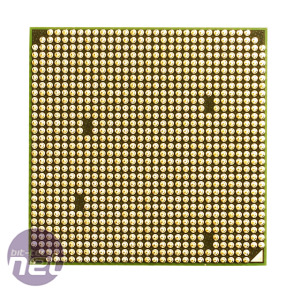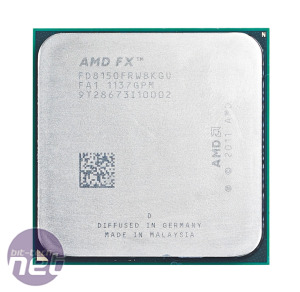AMD FX-8150 – why so bad?
Apart from the idle power draw of the FX-8150 – which we’ll point once again is an excellent achievement by AMD considering that the FX-8150 is a high-performance desktop part and its rival Core i5-2500K and Core i7-2600K are both essentially power-efficient laptop processors that have been beefed up a little for desktop PCs – the results show AMD’s latest CPU to be awful at everyday, consumer applications.It’s a lack of single-threaded performance that holds the FX-8150 back – its efforts in our single-threaded image editing test were dire compared to every other processor on test. Even worse, this supposedly 8-core CPU running at 3.6GHz was hardly much faster than a six-core Phenom II X6 1100T running at 3.3GHz in heavily multi-threaded applications that saturate all available execution cores. In Cinebench R11.5 and WPrime – applications where a 8-core CPU should dominate a 6-core (let alone a quad-core) – we saw a lack of performance.
The answer, we think, comes from Bulldozer’s history. We started this review with a brief history lesson for a reason: we really believe that Bulldozer was intended for servers and workstations, not desktop PC running consumer applications. The lack of grunt-per-core doesn’t matter too much in a server or workstation, as most professional applications are n-threaded and balance that load evenly to saturate every core available. Furthermore, it’s widely assumed that there will be an Opteron based on the Bulldozer design that incorporates eight modules, for 16 execution cores. Bulldozer, we believe, is built for massive parallelism.
The current top-end Opteron only has 12 cores (even if they’re more powerful individually) and only operates at 2.3GHz (the SE model at 2.5GHz is a rare, almost ‘built to order’ model). The high-frequency nature of Bulldozer should allow those 16 cores to run at a much higher frequency, potentially delivering more performance per CPU socket than the Magny-Cours design of the Opteron 6100-series. And Bulldozer is compatible with the current G34 Opteron CPU socket, so it’s a drop-in replacement – this staves off some temptation for server managers to consider the Intel Xeon alternative come next upgrade season.
This makes sense in the light of Tesla and FirePro graphics cards, where many simple ALUs are used to process highly parallel workloads of basic maths (pixel colours and the like). However, sometimes there’s no beating a full x86 integer execution core to get more demanding workloads done as quickly as possible. Servers are where CPU companies make most of their money, so we’re actually quite enthusiastic about AMD’s Opteron plans, and look forward to whether its radical design suits workstation and server workloads.
As a taster, consider that two 12-core Opteron 6174 CPUs managed 14.72 points in Cinebench R11.5. A single 8-core FX-8150 (without server- and workstation-optimised microcode) managed 6.01 – times that by three (as 3 x 8 = 24 = 2 x 12) and you get a score of 18.03, an improvement of 22 per cent for the same core count. Bulldozer’s Opteron debut will signal some interesting times for Xeon fans and AMD’s bottom line.
AMD FX-8150 Conclusion
Whether or not we’re correct about Bulldozer really being a server and workstation CPU, it’s terribly unsuited to the kinds of software we’re currently using on consumer PCs. This software is still heavily reliant on single-thread performance, and the FX-8150 just doesn’t have that. As such it’s woefully slow in a range of everyday applications.Worse still, it merely had mediocre performance in well-threaded desktop applications that should have played to the more parallel design of the CPU.
Possibly this situation will change in the future, with Windows 8 said to improve the thread management and AMD pushing compilers that take advantage of the new instructions in the Bulldozer design. The former claim could well happen, and AMD has a decent track record in getting its standards adopted industry-wide (AMD64, anyone?), so FMA4 and XOP could also be adopted as a standard. However, until a large amount of PCs support these instruction sets, we doubt we’ll see many compilers and applications use them. We’re also sceptical of buying a product now based on promises that it’ll be better in the future, unless that product happens to be worth buying now.
The final grievance is the price of the FX-8150 – at £205 it’s £37 more expensive than a Core i5-2500K and only £40 cheaper than a Core i7-2600K. It fails to outperform either conclusively, with only some victories over the quad-core i5-2500K in some heavily multi-threaded tasks. But if you’re after multi-threaded performance, the £40 extra for a Core i7-2600K is more than justified. Perhaps the 6- and 4-core flavours of the FX will prove interesting upgrades, but the FX-8150 definitely isn’t.
We therefore feel totally vindicated that at no point did we recommend any bit-tech reader to buy a Socket AM3+ motherboard ‘to get ready for Bulldozer.’ We merely reviewed these boards on the premise that they were new and that people might wish to buy one as an upgrade for a Phenom II system – we had no idea whether Bulldozer would be good, bad or indifferent, so we urged caution. Turns out we were right: the FX-8150 is a stinker.
-
Value14 / 35
-
Features9 / 15
-
Performance36 / 50


MSI MPG Velox 100R Chassis Review
October 14 2021 | 15:04












Want to comment? Please log in.